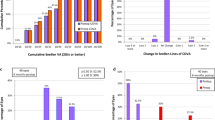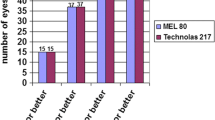Abstract
Comparison between treatment with wavefront optimized and custom-Q laser-assisted in situ keratomileusis (LASIK) ablations. Our study included 400 eyes of 200 patients divided into two equal groups. All patients were treated for myopia and myopic astigmatism with LASIK. The first group was treated with wavefront optimized ablation and the second group with custom-Q ablation. They were examined preoperatively and postoperatively to assess asphericity, image quality, and other classical outcome parameters. The wavefront optimized ablation group comprised 200 eyes with a mean spherical equivalent refraction (SE) of −5.2188 diopters (D) (range: −1.15 to −10.50 D); the mean Q-value changed from 0.30 preoperatively to 0.06 postoperatively. The custom-Q ablation group also comprised 200 eyes with a mean SE of −5.1575 D (range: −1.35 to −9.00 D); the mean Q-value changed from 0.32 preoperatively to 0.03 postoperatively. A statistically significant difference in postoperative change in Q-values (P = 0.02) and in postoperative visual acuity (P = 0.42) between the two groups was noted. There was no difference between the two groups regarding refractive correction. There was a marginally significant change in BSCVA (best spectacle-corrected visual acuity) between the two groups, and less impairment in the corneal asphericity in the custom-Q group.
Similar content being viewed by others
References
Munnerlyn CR, Koons SJ, Marshall J (1988) Photorefractive keratectomy: a technique for laser refractive surgery. J Cataract Refract Surg 14:46–52
Verdon W, Bullimore M, Maloney RK (1996) Visual performance after photorefractive keratectomy. Arch Ophthalmol 114:1465–1472
Seiler T, Kahle G, Kriegerowski M (1990) Excimer laser (193 nm) myopic keratomileusis in sighted and blind human eyes. Refract Corneal Surg 6:165–173
O’Brart DPS, Lohmann CP, Fitzke FW et al (1994) Disturbances in night vision after excimer laser photorefractive keratectomy. Eye 8:46–51
Holladay JT, Dudeja Dr, Chang J (1999) Functional vision and corneal changes after laser in situ keratomileusis determined by contrast sensitivity, glare testing, and corneal topography. J Cataract Refract Surg 25:663–669
Seiler T, Genth U, Holschbach A, Derse M (1993) Aspheric photorefractive keratectomy with excimer laser. Refract Corneal Surg 9:166–172
Applegate RA, Howland HC (1997) Refractive surgery, optical aberrations, and visual performance. J Refract Surg 13:295–299
Seiler T, Kaemmerer M, Mierdel P, Krinke H-E (2000) Ocular optical aberrations after photorefractive keratectomy for myopia and myopic astigmatism. Arch Ophthalmol 118:17–21
Mrochen M, Donitzky C, Wüllner C, Löffler J (2004) Wavefront-optimized oblation profiles: theoretical background. J Cataract Refract Surg 30:775–785
Kezirian GM, Stonecipher KG (2004) Subjective assessment of mesopic visual function after laser in situ keratomileusis. Ophthalmol Clin North Am 17:211–224
Patel S, Marshall J, Fitzke FW III (1993) Model for predicting the optical performance of the eye in refractive surgery. Refract Corneal Surg 9:366–375
Henslee SL, Rowsey JJ (1983) New corneal shapes in keratorefractive surgery. Ophthalmology 90:245–250
Anera RG, Jime′nez JR, Jimenez del Barco L et al (2003) Changes in corneal asphericity after laser in situ keratomileusis. J Cataract Refract Surg 29:762–768
Kiely PM, Smith G, Carney LG (1982) The mean shape of the human cornea. Opt Acta (Lond) 29:1027–1040
Sandoval HP, de Ferna′ndez Castro LE, Vroman DT, Solomon KD (2005) Refractive surgery survey 2004. J Cataract Refract Surg 31:221–233
Kohnen T, Bühren J, Kühne C, Mirshahi A (2004) Wavefront-guided LASIK with the Zyoptix 3.1 system for the correction of myopia and compound myopic astigmatism with 1-year follow-up; clinical outcome and higher order aberrations. Ophthalmology 111:2175–2185
Author information
Authors and Affiliations
Corresponding author
Rights and permissions
About this article
Cite this article
Tawfik, A., Eid, A.M., Hasanen, R. et al. Q-value customized ablation (custom-Q) versus wavefront optimized ablation for primary myopia and myopic astigmatism. Int Ophthalmol 34, 259–262 (2014). https://doi.org/10.1007/s10792-013-9828-1
Received:
Accepted:
Published:
Issue Date:
DOI: https://doi.org/10.1007/s10792-013-9828-1




